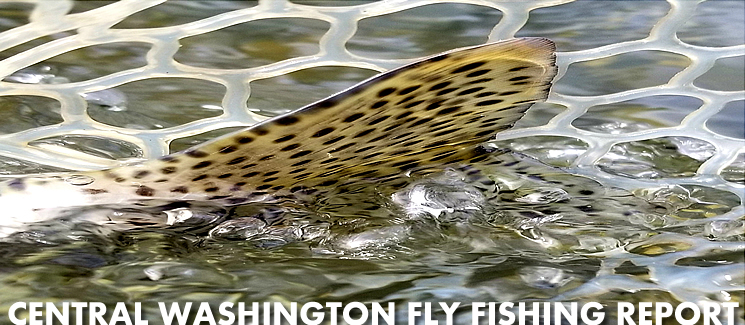|
The annual Yakima River flip flop that begins
each and every year, typically during the third
week of August, has completed its cycle and
fall fishing has commenced. Those high volume
river flows that last for more than 120 days on
Central Washington's infamous, blue ribbon, desert
trout stream, have dissipated and the Yakima is
now just a slow, gentle rolling trout stream.
|
|
The
Yakima River is notoriously noted as
this incredible Northwest trout
river that flows beautifully
through the Alpine terrain of the
Cascades Range. It quickly
gains momentum and slices through
the semi arid agriculture district
of the Kittitas Valley, where the
water is used to fertile its fields
of world famous, Timothy Hay.
It continues on a southerly flow and
over eons of time, has sliced like a
razor through a canyon of basalt, as
it flows southerly from the small town of
Ellensburg. Here, it changes contour and
direction, where it
eventually collides with the
Columbia River at the town of
Richland, Washington, well over 150
miles from its source.
|
|
|
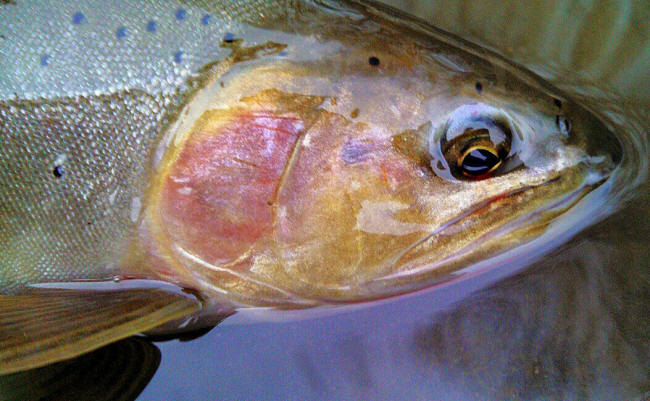 |
|
|
|
In its 70+
miles of
regulated fishing waters, the trout
grow naturally in its diverse and
amazing river bed. During a year
round fishing environment, the trout
legally can be hooked, played and
then safely and gently returned to
the water in which they came, but
only on a single barbless hook.
At no time, can fishermen of any
degree, cast a live or scented bait
into its waters. Only fur,
feathers and sharpened steel are allowed. |
|
|
|
During these 120 days of high
viscosity water flows, May to
the month of August, the river can
be intimidating, dangerous and
unapproachable on foot. For the
novice fishermen or drift boater, it
can also be unruly and require an
appropriate amount of time and
patience, to unlock its secret
trout world. It's always been noted
as a blue ribbon trout stream. However, it is also widely acclaimed
for its picky and
sophisticated trout. Here, even the
most experienced of fly fishermen
can find
difficult moments. |
|
|
|
As
you begin to spend more time
approaching and fishing this unique,
one of a kind trout stream, you will
hear many distinguishing words, like
drag free drift, Skwala Stonefly,
Hoppers, Yakima Canyon, bobber,
water releases, Chubby, Mother's Day
Caddis and eventually "Flip-Flop".
Such an unusual word that is not
typically associated with fly
fishing, however it has been an
important portion of the fly fishing
season for over 40 years, on this
bio-diverse, one of a kind, water way. |
|
|
|
Compared to other Northwest Rivers,
the Yakima is really an
adolescent fly fishing stream. The
popularity and discovery of this
river didn't take place until the
late 1980's, when two prodigal sons
of Ellensburg, Tim Irish
and Steve Probasco documented its
blue ribbon particulars in paperback
and VHS Video. |
|
|
|
They both understood and unlocked
its secret, formidable trout
realm better then anyone and brought
that to light during this time
period. Well known friends
throughout their youth, one son set
out to become and form the first fly
fishing outfitting business on the
Yakima River, while the other
traveled the globe transcribing his
fishing experiences in photographs
and published paper. |
|
|
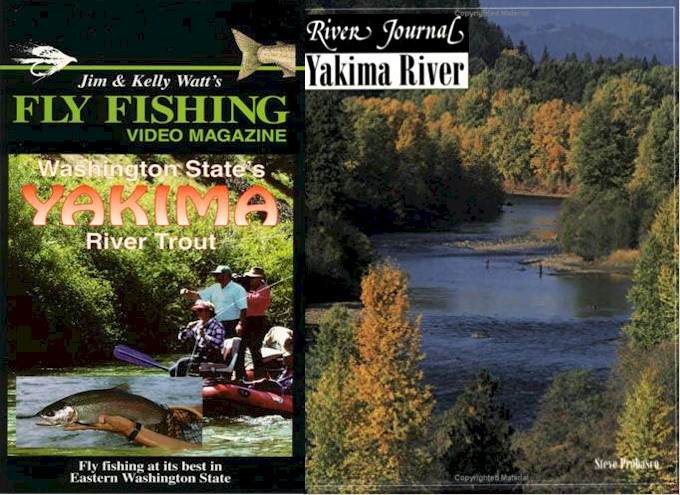 |
|
"YAKIMA RIVER WATER OPERATIONS" |
|
|
|
Water diversion has always been a
part of the Kittitas Valley history.
The earliest settlers that staked
their farming ground here in the
1800's, began by digging ditches and
canals to serve hundreds and even
thousands of acres of farm ground.
Many of those same canals are still
in existence today and still widely
used to distribute water across the
vast, agricultural lands of the
Ellensburg Valley.
|
|
|
|
In
the early 20th Century, the Army
Corps of Engineers set out to craft
and construct the four divisions of
what is now the Yakima River water
operations water management plan. Beginning in 1912,
with the construction of the Kachess
Reservoir, that produced a 7 mile
long, man-made water collections
facility, where they could
constitute quickly melting
winter snow pack,
in an inside perimeter and
distribute the water as it was
needed to local farmers. |
|
|
|
As
the demand for water increased, so
did the construction of both the
Keechulus Reservoir (1917) and the
Easton Reservoir (1929). Eventually
the largest storage supply resource
of them all, the Cle Elum Reservoir
was constructed (1933). Also the
Bumping Reservoir (1910) and the
Rimrock Reservoir (1925) were added
to collect the precious water
resource in the Naches River Valley. Upon
the
completion of this enormous project, the Bureau of
Reclamation was now solely in
distribution of water
operations,
controlling the flow of irrigation in 3
separate counties, hundreds of miles
from it's original source. |
|
|
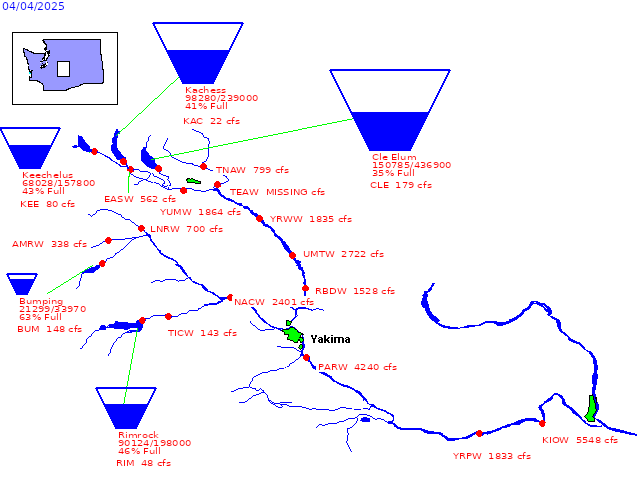 |
|
|
|
Undoubtedly, an amazing feat of hard
work, determination and the will to
surpass what Mother Nature, built
over ages of time. With this construction
effort and the erection of the Roza
Dam in 1939 in the bottom of the
Lower Yakima River Canyon, the water
resource to control millions of
gallons of water each season was now
constructed. |
|
|
|
During this time period, one has to
wonder how much thought was given to
the anadromous species that
populated the river, long before the
first settlers ever arrived.
The Yakima was an amazing,
bio-diverse water way that produced
some of the largest salmon runs in
the entire Evergreen State.
Here, Spring Chinook, Coho, Sockeye
and Steelhead were present most of
the year. With this now said, thousands,
perhaps millions of Anadromous
Salmonoids, were land locked, unable to
reach their spawning territory in
the upper watershed.
These same area's that had been
fortifyed as sacred spawning grounds for
thousands of years, was now
impassable, with a barrier of
encased cement and steel, spanning
five hundred feet wide and nearly
seventy feet high. |
|
|
|
For more then half a century, these
fish would be denied access to
their birth water and of course over
time, their numbers diminshed
greatly. Soon they were listed
"endangered" and catagorized as to
be extinct in the Yakima River
watershed. |
|
|
|
Looking at the scope of the entire
mission, I think it is fair to say
the engineers that designed this
water project had only the best of
intentions. Their dream of bringing
water to the desert, feeds a nation
and beyond each and every season,
with a vast food supply that is
distributed globally. It is
hard to believe they set out to
destroy an entire colony of fish
species. I say this without issue. |
|
|
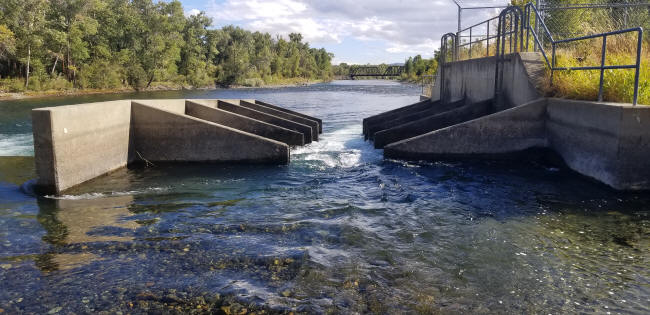 |
|
|
|
During their construction, Roza and
Prosser Dams, along with the
diversions at Horns Rapid, Union Gap
and Throp, were all constructed with
fish bypass latters. However,
inadequate water supply and poor
engineering of these fish passage
portals in the early 19th Century,
didn't allow these incredible fish
to circumnavigate freely in between. |
|
|
|
Now, with much improved science and
engineering, along with a coalition
of native Yakama tribal biologists,
the movement to recolonize these
migrating Pacific salmoniods is
underway and as of today is our
driving force in crafting one of the
best wild, trout fisheries in the
entire country. |
|
|
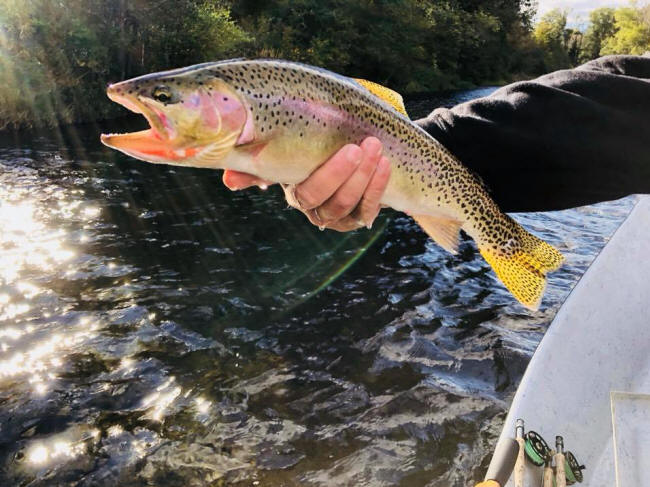 |
|
|
|
The reintroduction of salmon to the
Yakima is an ongoing project and for
the past fifteen years, we have
steadily seen these amazing fish
reappear in the upper watershed once
again. Their bio-mass is
strengthening this stream, as they
perform and propagate the ritual of
spawning each autumn. The
native tribes of the Pacific
Northwest were convinced that salmon
were the life blood of our rivers.
It's hard to dispute such a fact,
when you see the results in a
fishery such as the Yakima. |
|
|
|
Some would prefer to attribute the Yakima's
success to our state's fish & game
fishing policy of catch & release
that was established in the early
1990's. I have to strongly
disagree. The enforcement of
this regulation, most certainly has
facilitated in rebuilding the stocks
of wild trout in our system.
However, it is the salmon stocks
that are providing the heavy
nutrient content, that enables the
trout and aquatic insect populations
to populate, prosper and grow to the
levels we are now seeing. With over
twenty five years of experience and
thousands of days on the river, my
daily obseravations from season to
season can only attribute it to
this. |
|
|
|
"FLIP-FLOP" |
|
|
|
Each and evey winter, snow pack to
different degrees, accumulates in
the mountains surrounding the
Kittitas Valley. If we are
lucky, we experience a lavish winter
and the anglur basalt, granite rich,
Cascade Range are engulfed with
hundreds of inches of snow fall.
In the early spring, much of this
low lying snow begins to melt and by
design, the reservoirs begin
filling, collecting as much water as
possiable. |
|
|
|
Even with four storage reservoirs
deliberately fashioned to collect
this supply, much of this precious
commodity is lost to natural free
flowing tribuataries that feed the
Yakima River. These smaller
rivers and streams, burst with
spring run-off and a percentage of
water is flushed naturally through
the system, much like Mother Nature
orginally intended. At no
point or time does man have any
control of what it does or where it
goes. |
|
|
|
After this annual spring event
occurs, the entire Yakima Basin is
controlled strictly by water
releases dictated by the reservoirs.
Most of the water that fills the
banks of the Yakima during the 120
day summer cycle, orginates from the
Cle Elum Reservoir. Water is
released from the Cle Elum pool into
the Cle Elum River and the two
rivers collide at the confluence of
the Yakima, just above the historial
coal mining town of Cle Elum. Water
is delivered to those in need by
diversions and canals that finger
across the valley for miles. |
|
|
|
As we near the 3rd week of August
each year, water flows from the
reservoirs begin to slow.
Islands, sturctures and other
particulates that have been buried
under water for several months begin
to appear and a new look and feel
begins on this river. |
|
|
|
The hurried, fast pace
water flows of summer begin to
drop, and the "Flip-Flop" is
initiated. Water releases are cut
substantially that supply the Yakima and reservoirs that were
once filled to capacity, are now just
a puddle in comparison. |
|
|
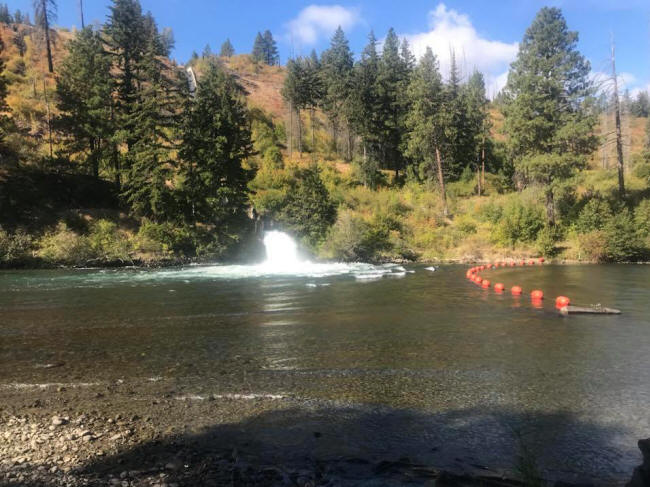 |
|
|
|
As the Yakima flows continue on a
downward decent, the water from
Kachess Reservoir is diverted into
Lake Easton. In turn, the water is
then rerouted from the Easton Dam
into the Highline Canal, which runs
parallel to Interstate 90 southward.
After flowing several miles in an
entombment of cement and steel, some
of the water is redirected and
abruptly drops off the hillside at
Bristol Flats (above picture).
Here, cool reservoir water is
injected into the desert stream from
this bypass. As you can see from the
picture above, buoy's are place
above water junction to keep any
potential, inexperienced river
runners from a dangerous and
possibly deadly disaster. |
|
|
|
Water diverted from the Highline
Canal into the Yakima will continue
to drop into the system for several
weeks. Of course, this varies
from year to year dependant soley on
water storage and usage needs. Now,
water flows are increased in the
Naches River drainage as releases of
water from Rimrock and Bumping
Reservoir, feed the needs of the
local farmers in Yakima and Benton
Counties. Due to a warmer,
drier climate in the lower valley,
their water requirments and
irragation demand operate on a
longer cycle. |
|
|
|
So the "flip" of water to the
Nachess system and the "flop" of
water lowered in the Yakima system,
hence the name-"Flip-Flop". |
|
|
|
"AUTUMN IS PRIME TIME" |
|
|
|
The Yakima River is a three hundred
sixty five day
fishery and most of the year it
produces excellent trout fishing,
dependant soley on stream and
weather conditions of course.
However, September and October for
many moons has been known to be the
undisputed "Prime
Time" months of the season to
fish the "Yak". |
|
|
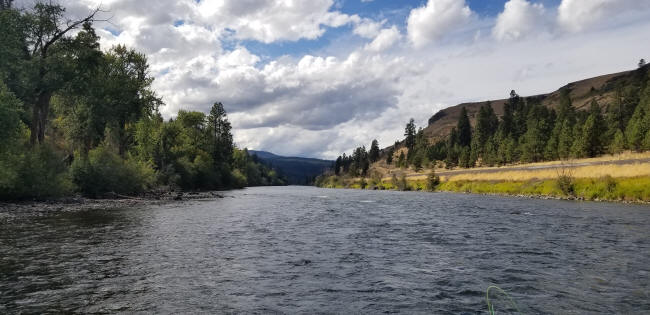 |
|
|
|
With water flows receding, easy
access opens up in a wider range of
areas for those that prefer to fish
on foot. Wading bank to bank in most
areas is easily accomplished for
most anglers. For those traveling by
boat, less energy is needed to
control your craft and avoiding
natural obstacles, like boulder
fields and root wade's
becomes more of a concern, rather
then slowing the speed of the boat.
During the high water season, most
of these impediments are buried
under several feet of water.
Shortening your drift will be
required as the stage and flow are
much slower. Trying to cover
big pieces of the river doesn't
leave you time to present
the fly accordingly, especially to
feeding fish. |
|
|
|
Trout will also have far less places
to seek refuge, unlike the summer
months of
higher water conditions. Large
trout behave as they do in many
other northwest rivers, taking up
the prime feeding lies. The
grassy banks
of the Yakima no longer hold fish.
As water temperatures begin cooling,
aquatic feed begins showing up in
great numbers. |
|
|
|
Autumn undoubtedly produces the
best hatches of the season on
the "Yak". Craneflies, a
direct descendant of the Chironomid,
begin returning to the slow moving
water of the river to lay their
eggs. Skating, twitching and
swinging a crane pattern
appropriately will many times deliver
some absolutely amazing fish. |
|
|
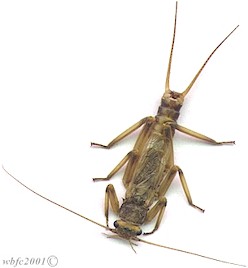 A
summer Stonefly hatch will commence
with the water drop, and the
Shortwing Stone in both nymphs and
adults will become an important food
opportunity for several weeks of
September. A
summer Stonefly hatch will commence
with the water drop, and the
Shortwing Stone in both nymphs and
adults will become an important food
opportunity for several weeks of
September.
Kicking over rocks along the waters
edge will uncover many of these
stonefly species. Big females
will take flight over the water
during the warmest portions of the
day. Keep in mind in low, clear
water conditions, these large
insects, project an
enormous profile, to foraging fish.
Nymphing in the early portions of
the day with your favorite stonefly
pattern, sizes 8-10 should produce
results in most water types.
Water temperatures at this time will
dictate the appropriate water to
concentrate your energy and efforts
in. |
|
|
|
One of the most relished food
sources for trout on the Yakima is
the Blue Wing Olive Mayfly.
With desending water flows, millions
of BWO nymphs begin moving along the
sub-straight of the river during the
month of September. Many times
throughout the fall, this will be
the major food source for many
resident trout. |
|
|
|
As the month of October approaches,
maturing nymphs will begin their
fall emergence and the little bug
fishing on the river appears.
This is our most techincal time to
fish and will test your skills
ability to present the fly cleanly
to constantly feeding fish, impal
the small hook into hardened
cartilage and fight the fish on
thin, clear monofliament tippet. |
|
|
|
Casting the ideal fishing tool, with
plenty of built in tippet protection
is a wise choice during this time.
A fast, stiff, broomstick like
action fly rod
will do you know good here.
With these lifeless types of
flyrods, it is highly likely that you will pull hard
setting the hook in bone and
with no give in the tip or
midsection, the mono line will
seperate, snapping in two, detaching you and the fine
Yakima River trout forever. Choose
your weapon of choice wisely, when
shopping for the perfect
presentation stick! |
|
|
B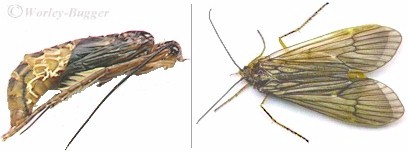 y
the end of September, the largest
species of the Caddisflies will be
hatching througout the entire Upper
Yakima River Basin. This burnt
orange, colored Caddisfly will be
convulsing and propelling it body
violently on the rivers surface well
into the month of November. y
the end of September, the largest
species of the Caddisflies will be
hatching througout the entire Upper
Yakima River Basin. This burnt
orange, colored Caddisfly will be
convulsing and propelling it body
violently on the rivers surface well
into the month of November.
Often referred to as the "Halloween"
Caddis, this hatch stirs the
adrenline of most accoomplished fly
anglers and it is a favorite to fish
among many. |
|
|
|
Casting large, orange bodied dry fly
imatations can bring the
largest of the Yakima trout to the
surface. Do not overlook the
importance of the pupa either.
Swinging a wet fly pupa under the
surface will produce violent,
agressive strikes as well. For
many this time of year, the "tug is
the drug" as they like to say. |
|
|
|
October Caddis hatches are legendary
in the Pacific Northwest on many of
our fine rivers. It's also a
preferred food items for Columbia
River Summer Steelhead. In the
tribuatairies of the Columbia,
swinging and skating October Caddis
can be an exciting addition to the
day's activities as well as a
productive means of catching these
ocean-going rainbow trout. |
|
|
|
"EP·I ·LOGUE" |
|
|
|
We are Pacific Northwesterners and
make our home in what we consider
"Gods Country". This has to be
the finest two months of the year to
be outdoors. With that being
said, this is the "Prime Time" fly
fishing months for us in Central
Washington. |
|
|
|
However, be forewarned, like I
mentioned above in this newsletter, this
is the "Yak" and the trout will not
tolerate poor, imperfect techinque.
For them to be hooked on fur and
feathers, they demand a profreicent
caster, a drag-free presentation and
the skill set to apply enough
pressure to bring them to hand.
Don't venture to the river,
expecting to catch the mightiest of
trout, without the skill set,
knowledge and energy to do so.
Fly fishing is the sport of kings as
well as the "thinking man's fishing"
and the fare that we chase, demand a
formitable adversary. If it
was easy, everyone would do it! |
|
|
|
Make sure you take advantage and get
out and explore not only Central
Washington's, Yakima River, but the
many beautiful fisheries right in
our own back yard. I will see
you out there. |
|
|
 |
|
|
|

